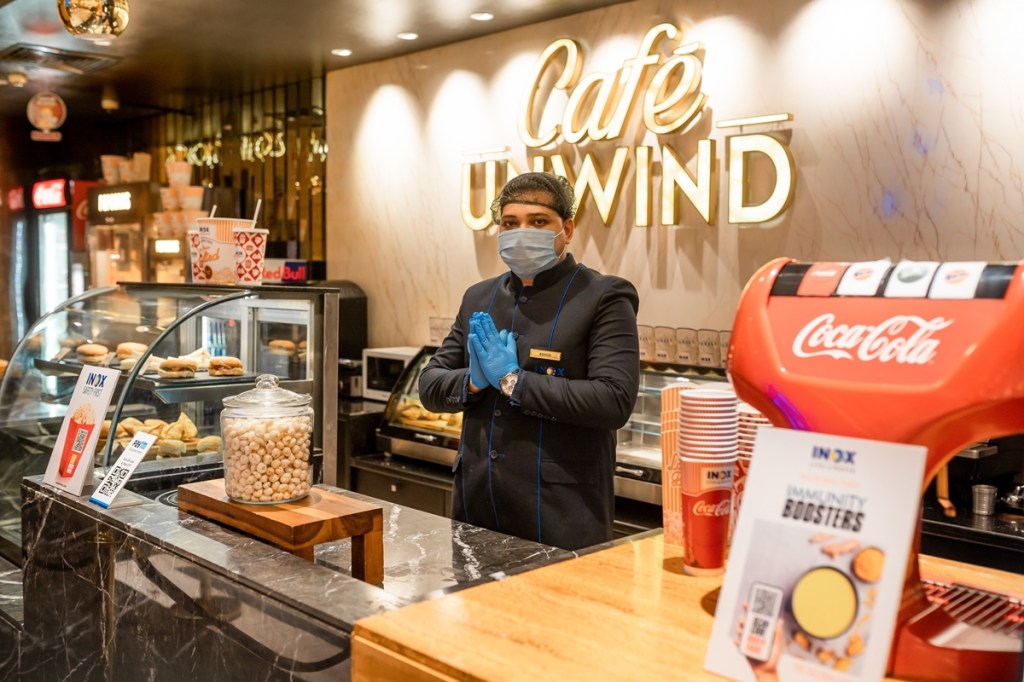Movie theatres are expanding their food and beverage business to beat the pandemic blues. After cloud kitchens, and home delivery of popcorn and nachos through food delivery aggregators, multiplex chains are turning their food counters into cafes. Very early into the pandemic last year, Carnival Cinemas launched its cloud kitchen business. In July, 2021, PVR Cinemas began selling microwaveable popcorn under the brand name Popmagic. From September 2021, people can step into an Inox Insignia lounge or Café Unwind counters or any other concession stalls within Inox multiplexes without buying movie tickets.
Pivot to popcorn
In CY20, the filmed entertainment industry saw an 80% decline across domestic and international theatrical revenues, according to the FICCI-EY Media and Entertainment Report 2021. As per a CRISIL Ratings report, a full recovery of the multiplex business is expected in FY23. This has forced multiplex owners to cut costs and find alternative revenue streams to stay afloat.
Food and beverage (F&B) consumption at cinema theatres has been a significant contributor to the revenue of multiplex owners. For instance, 30% of the overall revenue of PVR Cinemas — about Rs 1,000 crore — comes from F&B; for Inox Leisure, this number is 25%.
Gautam Dutta, CEO, PVR, says that broadening the scope of the F&B business was a reasonable option as, “we have been able to roll out this service without having to spend any extra money on rent, manpower, leadership, or adding spare capacity”. PVR’s brand of popcorn, nachos, hotdogs, etc, are available on Swiggy and Zomato; its microwaveable popcorn can be ordered on e-commerce sites. Dutta expects that in five years or so, these new revenue channels will bring in 7-10% incremental income.
Kunal Sawhney, COO, Carnival Cinemas, says that the company’s F&B venture has had more takers from tier II and III cities than metros and tier I cities, as there is less competition from branded QSR chains in smaller towns. “The average ticket size for our home delivery orders is Rs 400. About 60-65% of the orders are for sandwiches, burgers and pizzas, whereas the in-theatre consumption is heavily skewed (about 70%) towards popcorn,” he says.
In its dining outlets, Inox Leisure offers everything from popcorn and samosas, to oriental and Italian dishes. The company is planning to expand its menu to attract a wider clientele. “Our consumers will soon be able to enjoy meal options like pulao, biryani, dal makhani, and a range of beverages too,” informs Dinesh Hariharan, VP – food & beverages, Inox Leisure. The company plans to introduce ready-to-eat products as well.
Survival tactic
Even though these companies earn a third of their revenues from F&B sales, it is unlikely that consumers will choose to eat at their outlets or even order-in much, say analysts. Multiplexes may find it difficult to translate their entertainment brand equity into the F&B sector. “One of the challenges with multiplexes selling food independent of cinemas is that consumers do not know what to expect when they order from one of these outlets, since they aren’t known for a particular taste or cuisine,” points out Anchit Chauhan, cluster director, TBWA, India.
Multiplex chains believe there is a demand for the typical food moviegoers consume while at a cinema theatre. But that may not be the case, say analysts. “These businesses are finding ways to survive and sweat their assets. This supply-led business model is not sustainable,” says Anand Ramanathan, partner, Deloitte India.
Chauhan expects this to be a temporary intervention. When normalcy returns, a large chunk of the F&B business for these chains will continue to come from sales at cinema halls.
Read Also: How online gaming is caught between an international sporting event and state legislations
Follow us on Twitter, Instagram, LinkedIn, Facebook

